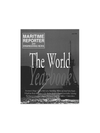
Page 53: of Maritime Reporter Magazine (June 1999)
Read this page in Pdf, Flash or Html5 edition of June 1999 Maritime Reporter Magazine
10 Significant Marine Innovations retractable for DP; two bowthrusters in tunnel for DP.
The vessel is designed to accommo- date an optional thruster in order to increase the operational bollard pull from 50 MT to 80 MT, if it appears to become necessary in the future. State of the art equipment has been chosen and installed based on proven technology.
The DP capacities are: • In pipelaying mode DYNPOS
AUTR, DNV DP II, with 50T bollard pull at sea state 5 and a current of 1.5 knots all acting abeam • In subsea mode DYNPOS AUTRO,
DNV III, without bollard pull with the same other conditions.
The capacities are such that the vessel has autonomy well above 30 days; this characteristic is important considering the sites of operation and the opportuni- ties to work on both sides of the Atlantic
Ocean. The cruising speed of 14 knots allows the vessel to move rapidly from one site to another.
Quad joint strings prepared on the fir- ing line (52 m length maximum) will be installed through the J-lay tower in fric- tion or collar mode, with a hang off clamp at the bottom and a traveling clamp to allow the transit of the string in the tower. The tower is designed for 400
MT tension with a tilting angle of 45 to 96 degrees; however, this maximum ten- sion capacity is expected to be used only in emergency case (for recovery of flooded pipes for instance), limiting the required tension to 320 MT in normal use. Preliminary calculations show that such tension allows the laying up to 2,000 msw for pipes in the range of 14 to 16-in. The tower itself is designed for pipes up to 24-in. outside diameter.
The firing line is organized on the deck to assemble the quad-joints strings in five working stations for welding,
NDT and coating. The large space on deck (3,000 sq. m.) is available for stor- age of standard pipe joints (12 m) or onshore-prepared quad-joints for pipe- in-pipe flowlines or special steel. Large capacity and heavy racks are loaded without any external help thanks to the main crane capacity.
Installation of flexible pipes (up to 17- in. ID) is executed through the J-lay tower or a chute with the use of four pad tensioners (maximum of three).
Combined installation of several pipes or pipes and umbilicals in parallel is one of the characteristics of the vessel, as it can be deducted from the description here above the design of the vessel for the pipelaying has been developed in order to install every type of pipe and umbilical, commonly used in deep water fields; the number of vessels on site being therefore limited to the FDS itself.
Keeping in mind this criteria and in order to have the possibility to work in autonomous mode the lifting capability of the FDS is very interesting: • One main crane of 600 MT at 30 m and 300 MT at 55 m; • Two 30 MT auxiliary cranes; • Two 20 MT auxiliary cranes.
With such characteristics, handling and lifting of pipes and racks on board, modules installation on FPSO or on any floating units (SPAR, TLP etc...), tem- porary decks or module support frames as well as installation of mooring sys- tems can be executed.
The lifting and handling capabilities are increased by the utilization of the
A&R winches (400 MT to 3,000 m WD or 600 MT to 1,500 m WD) and an aux- iliary winch (100 MT) associated with a specific portside modules handling tower to allow for safe transfer and installation of modules from deck to sea.
NeM" Simulator Training for
Pilots and Tug Captains
Tractor Tug
Handling for Pilots
A three-day course in tractor- tug capabilities and utilization for Marine Pilots. The purpose of this course is to develop skills as they pertain to Z-drive and VS tractor tugs. It provides an opportunity to experience new ways of handling these highly maneuverable tugs.
Course begins with an introduc- tion to tractor-tug types, then proceeds through tug place- ment and the effect on the assisted vessel. Also includes tug capabilities and limitations by types: Voith-Schnieder propulsion, azmuthing bow- and stern-driven tugs and combi- tugs. Choice of ship size/type, harbor, piers, winds, tug/s.
Advanced Tug
Operations
A three-day course for Tug
Captains and Mates to help them develop advanced skills in transitioning from cable-towing to pushing mode and swinging on the hip - heads or tails. During simula- tion exercises, the tug and the barge (or ship) each react to forces independently (sliding, heeling, turning, etc.). Various type tugs (conventional, tractor, etc.) and barge- or ship-sizes are available. Simulator exercises can be conducted in your Port or Waterway.
To schedule these courses at any MSI Center, call Tom Garrigan at 718-565-4183 or submit your request via our website www.marinesafety.com. MarineSafety international *
New York, NY Newport, Rl Norfolk, VA San Diego, CA Rotterdam, Neth. (718)565-4180 (800)341-1353 (757) 423-2320 (619)231-3333 +31 10 486 66 54
June, 1999 Circle 221 on Reader Service Card 55

 52
52

 54
54
